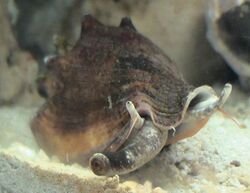Biology:Strombus alatus
| Strombus alatus | |
|---|---|

| |
| Front view of S. alatus showing the snout in front and stalked eyes behind, one of which reaches out through the stromboid notch in the shell | |

| |
| Scientific classification | |
| Domain: | Eukaryota |
| Kingdom: | Animalia |
| Phylum: | Mollusca |
| Class: | Gastropoda |
| Subclass: | Caenogastropoda |
| Order: | Littorinimorpha |
| Family: | Strombidae |
| Genus: | Strombus |
| Species: | S. alatus
|
| Binomial name | |
| Strombus alatus (Gmelin, 1791)
| |
| Synonyms | |
| |
Strombus alatus, the Florida fighting conch, is a species of medium-sized, warm-water sea snail, a marine gastropod mollusk in the family Strombidae, the true conchs. Its name derives two Latin words. Strombus means, in Latin, a snail with spiral shell, which derives from the Greek στρόμβος, meaning anything turned or spun around, like a top or, as in Aristotle's Historia Animalium, a sea snail. Alatus means, in Latin, "winged".
Distribution
This conch occurs in the Western Atlantic Ocean from North Carolina to Florida and the Gulf of Mexico, Louisiana, Texas , and the east coast of Mexico.[1][2]
Description
The shell can be as large as 112 mm (4.4 in).[1][3]
This species is closely similar to Strombus pugilis, the West Indian fighting conch, which has a more southerly range. S. alatus shells have less prominent subsutural spines and slightly more projected outer lips. Some scientists have treated the two as distinct species; others as subspecies.[4] In an extensive study of the Stromboidea in 2005, Simone provisionally treated these as distinct species, but observed, "no spectacular morphological difference was found [and] all related differences, even those of the genital system, can be regarded as extreme of variation of a single, wide distributed, variable species."[5]
Phylogeny
A cladogram based on sequences of nuclear histone H3 gene and mitochondrial cytochrome-c oxidase I (COI) gene showing phylogenetic relationships of (32 analyzed) species in the genus Strombus and Lambis, including S. alatus, was proposed by Latiolais et al. (2006):[6]
| ||||||||||||||||||||||||||||||||||||||||||||||||||||||||||||||||||||||||
| Phylogeny and relationships of Eastern Pacific and Atlantic Strombus species, according to Latiolais et al. (2006)[6] |
Habitat
The minimum recorded depth for this species is the surface; the maximum recorded depth is 183 m.[3]
References
- ↑ 1.0 1.1 "Malacolog ver. 4.1.1". The Academy of Natural Sciences. http://www.malacolog.org/search.php?nameid=2190. Retrieved 2009-09-30.
- ↑ Perry, H.; Larsen, K. (2004). "Strombus alatus Gmelin, 1791 Florida Fighting Conch". A Picture Guide to Shelf Invertebrates from the Northern Gulf of Mexico. http://www.gsmfc.org/seamap/picture_guide/Gastropods/strombus%20alatus.pdf. Retrieved 27 June 2010.
- ↑ 3.0 3.1 Welch J. J. (2010). "The "Island Rule" and Deep-Sea Gastropods: Re-Examining the Evidence". PLoS ONE 5(1): e8776. doi:10.1371/journal.pone.0008776.
- ↑ Simone (2005): Comparative Morphological study of representatives of the three families of Stromboidea and the Xenophoroidea (Mollusca, Caenogastropoda), with an assessment of their phylogeny , p. 142.
- ↑ Simone (2005): Comparative Morphological study of representatives of the three families of Stromboidea and the Xenophoroidea (Mollusca, Caenogastropoda), with an assessment of their phylogeny , p. 169.
- ↑ 6.0 6.1 Latiolais J. M., Taylor M. S., Roy K. & Hellberg M. E. (2006). "A molecular phylogenetic analysis of strombid gastropod morphological diversity". Molecular Phylogenetics and Evolution 41: 436–444. doi:10.1016/j.ympev.2006.05.027. PDF.
Wikidata ☰ Q2406411 entry
 |


